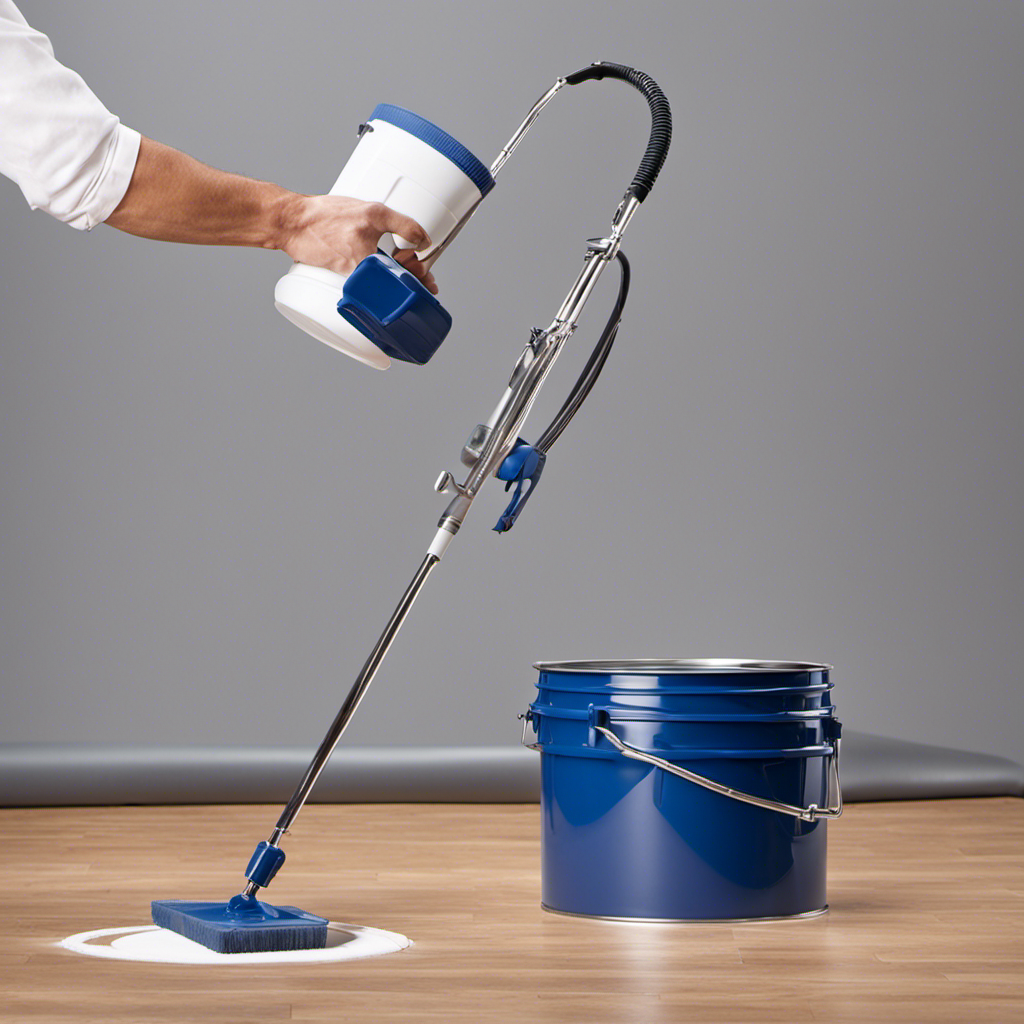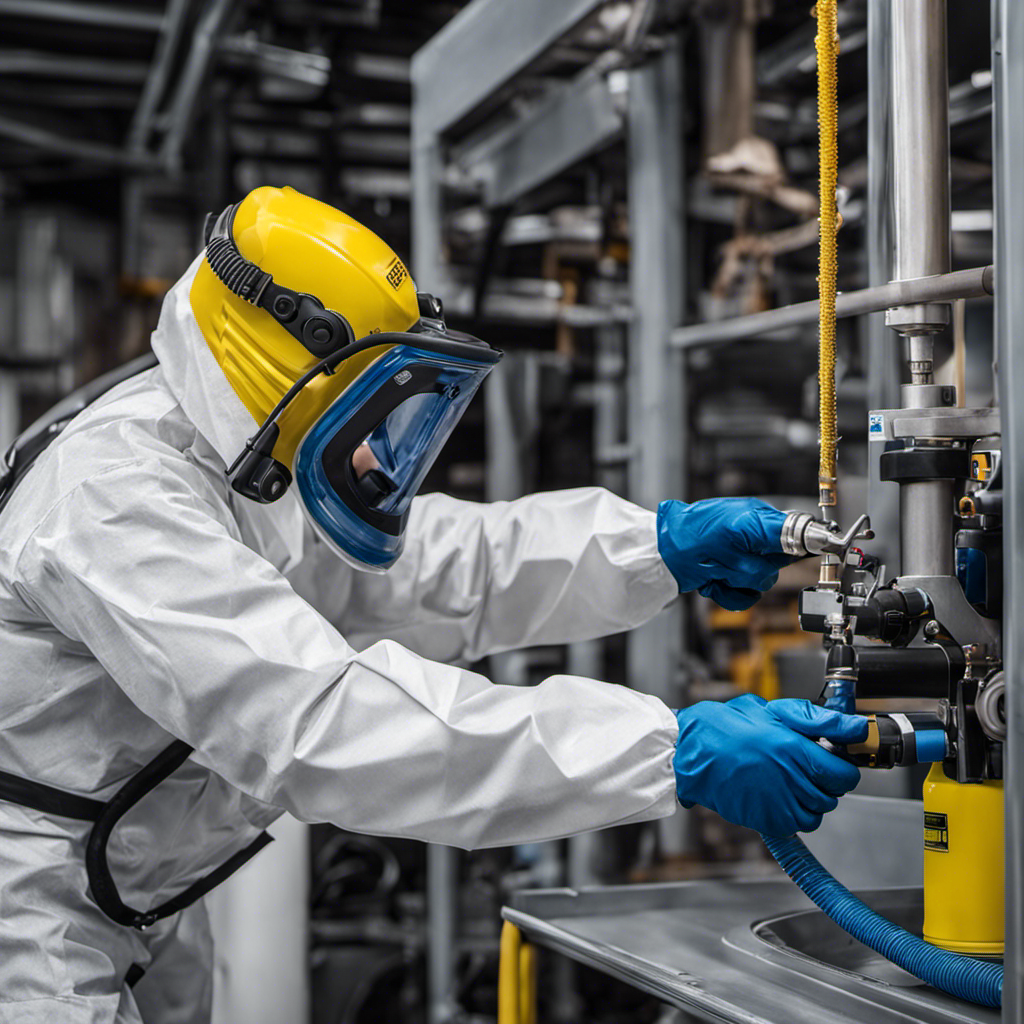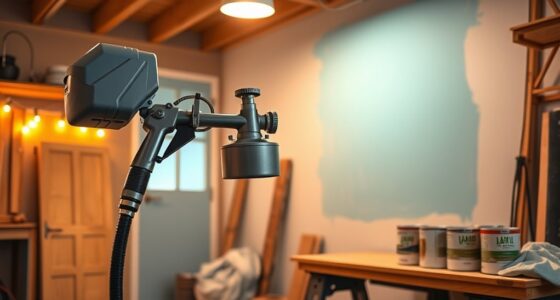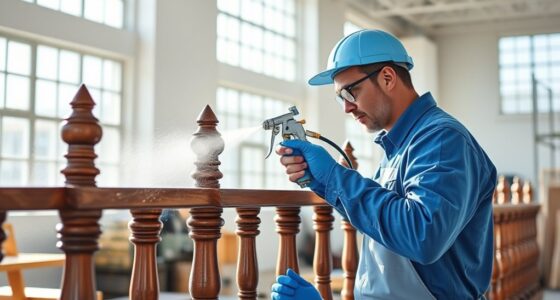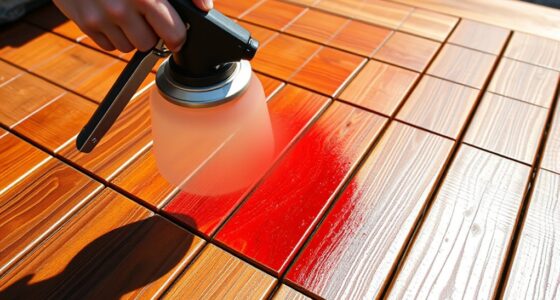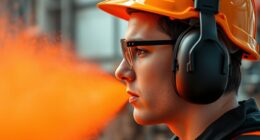Thinning latex paint is crucial for getting the best results when using airless spray equipment. Did you realize that the thickness of the paint significantly affects how well the sprayer works? To ensure a smooth spray pattern, avoid blockages, and achieve a high-quality finish, it is important to properly thin the paint.
Thick paint can lead to uneven coverage, strain on the sprayer, and potential malfunctions. This article explores the importance of thinning latex paint, provides guidance on following manufacturer recommendations, and offers tips for troubleshooting and achieving flawless application.
Key Takeaways
- Thinning latex paint is crucial for optimal performance and results when using an airless sprayer.
- Properly diluted consistency ensures smooth flow, prevents clogging, and delivers a professional-looking finish.
- Gradually thin the paint and test the consistency to achieve a flawless application.
- Use paint strainers, mix thoroughly, and follow manufacturer’s guidelines for pressure adjustments to ensure consistent spray patterns and prevent uneven application.
Importance of Thinning Latex Paint for Airless Sprayers
Thinning latex paint is crucial for airless sprayers to achieve optimal performance and ensure a professional-looking finish. Understanding paint viscosity is key in this process.
The viscosity of the paint refers to its thickness, and it greatly affects the performance of the sprayer. When the paint is too thick, it can lead to uneven coverage, strain on the sprayer, and potential malfunctions or premature wear.
Troubleshooting paint thinning issues is important to achieve the desired consistency. Gradually thinning the paint and testing the consistency is recommended. Paint thinners, water, latex paint conditioners, and commercial paint thinners can be used for thinning.
It is essential to follow the manufacturer’s recommended thinning ratios for the specific paint and sprayer model to ensure smooth flow and prevent clogging.
Understanding the Viscosity of Latex Paint
Understanding the viscosity of latex paint is crucial for achieving smooth flow and preventing clogging when using an airless sprayer. The viscosity refers to the thickness or resistance to flow of the paint. It is measured in Krebs Units (KU) or seconds (s) using a viscometer.
The impact of viscosity on the spray pattern is significant. If the paint is too thick, it will not flow properly through the sprayer and may result in uneven coverage or clogging. On the other hand, if the paint is too thin, it may cause the spray pattern to become distorted or splatter.
Finding the right viscosity is essential for a consistent and professional-looking finish. Referencing the manufacturer’s guidelines and using a viscosity cup for testing can help determine the appropriate thinning ratio to achieve optimal viscosity.
The Role of Consistency in Achieving Optimal Performance
Maintaining the proper consistency of the paint is crucial for achieving optimal results when using an airless sprayer. The impact of paint texture cannot be underestimated in achieving consistent results.
When the paint is too thick, it can lead to uneven coverage and strain on the sprayer, potentially causing malfunctions or premature wear. On the other hand, if the paint is too thin, it can result in poor coverage, streaks, uneven color, and running paint.
Achieving the right consistency involves following the manufacturer’s guidelines for thinning ratios, gradually thinning the paint while testing the consistency, and adjusting ratios as needed. It is important to use the appropriate thinning agents, such as paint thinners or water, and to mix the paint thoroughly to achieve a uniform mixture.
Effects of Thick Paint on Airless Sprayer Performance
Excessive thickness of the paint can strain the airless sprayer and result in uneven coverage, potential malfunctions, or premature wear.
When paint is over-thinned, it can cause a whole new set of issues. The consistency becomes too thin, leading to poor coverage, streaks, uneven color, and running paint.
Achieving a smooth flow and preventing clogging is essential for optimal performance. To ensure this, follow the manufacturer’s recommended thinning ratios for the specific paint and sprayer model. Gradually thin the paint, testing the consistency along the way.
Paint thinners, water, latex paint conditioners, and commercial paint thinners can be used for thinning.
Properly preparing the paint and equipment, as well as calculating and mixing the thinning ratio accurately, will help prevent potential problems and ensure a professional-looking finish.
Following Manufacturer’s Recommendations for Thinning Ratios
Following the manufacturer’s recommendations is crucial for achieving the desired consistency and preventing potential issues when diluting latex paint for airless sprayers. Here are four important points to consider when following the recommended thinning ratios:
-
Thinning ratio variations: Different paint brands and airless sprayer models may have varying thinning ratios. It is essential to consult the manufacturer’s guidelines to determine the correct ratio for your specific combination.
-
Gradual thinning and troubleshooting over-thinned paint: It is recommended to thin the paint gradually, testing the consistency along the way. This approach allows for adjustments if the paint becomes over-thinned. Over-thinned paint can result in poor coverage, streaks, uneven color, and running paint.
-
Consistency testing and adjustment: Use a viscosity cup or test surface to measure the consistency of the thinned paint. Based on the test results, adjustments can be made to achieve the desired consistency.
-
Following guidelines for pressure adjustments: In addition to following the thinning ratio, it is important to adjust the airless sprayer’s pressure according to the manufacturer’s guidelines. This ensures consistent spray patterns and prevents uneven application.
Gradual Thinning Technique for Smooth Application
When thinning latex paint for airless sprayers, it is important to consider the technique used.
One technique is gradual thinning, which involves adding small amounts of thinning agent incrementally until the desired consistency is achieved. This method allows for better control over the viscosity of the paint and helps to prevent over-thinning.
In contrast, immediate thinning involves adding a larger amount of thinning agent all at once. While this method may seem quicker, it can be harder to achieve the desired consistency and may result in over-thinning the paint.
The choice of thinning agent can also impact the final outcome. Different thinning agents, such as water, latex paint conditioners, or commercial paint thinners, can have varying effects on the paint’s viscosity and flow.
It is important to choose the appropriate thinning agent based on the specific paint and sprayer model being used.
Choosing the Right Thinning Agents for Latex Paint
Water, latex paint conditioners, and commercial paint thinners are some options to consider when choosing the right thinning agents for latex paint. Thinning latex paint is essential for achieving optimal performance when using airless sprayers. To ensure the best results, it is important to use the proper techniques for thinning latex paint. Here are some key points to keep in mind:
-
Consider the type of thinning agent: Water is a common and cost-effective option for thinning latex paint. Latex paint conditioners can improve the flow and leveling properties of the paint. Commercial paint thinners are specifically designed for thinning latex paint and may offer better performance.
-
Follow manufacturer’s recommendations: Different paints and sprayers may have specific thinning ratios. It is important to follow these guidelines to achieve the desired consistency for spraying.
-
Gradually thin and test the paint: Start by adding a small amount of thinning agent and gradually increase until the desired consistency is achieved. Test the paint’s flow and coverage on a test surface to ensure it is suitable for spraying.
-
Avoid over-thinning: Over-thinning the paint can lead to poor coverage, streaks, and running paint. It is important to find the right balance to achieve optimal performance.
Mixing Ratios: Finding the Perfect Balance
To achieve the perfect balance in mixing ratios, the painter gradually adds the thinning agent and tests the consistency until it is just right. Finding the right dilution is crucial for achieving optimal performance when thinning latex paint for airless sprayers.
The painter must carefully follow the manufacturer’s guidelines for the recommended thinning ratio, as it can vary depending on the type of latex paint and airless sprayer being used. By measuring and calculating the proper proportions, the painter can pour the measured paint into a clean container and gradually add the thinner while stirring continuously. It is essential to thoroughly blend the mixture until a consistent mixture is achieved.
Troubleshooting thinning issues can be done by using a viscosity cup or test surface to measure the consistency of the thinned paint and making adjustments accordingly. By following these techniques and guidelines, the painter can achieve optimal performance and avoid common mistakes such as over-thinning the paint or not following recommended thinning ratios.
Preparing Paint and Equipment for Airless Spraying
The painter strains the paint and thoroughly mixes it with a stir stick to ensure a uniform consistency before using the airless sprayer. This step is crucial in preparing the paint and equipment for airless spraying.
To achieve optimal performance, the painter must also adjust the nozzles, tips, and spray patterns for airless spraying. This ensures a precise and even application of the paint.
Additionally, cleaning and maintaining the airless sprayers is essential for long-term use. Regular maintenance, such as cleaning the filters, flushing the system with clean water, and inspecting the spray gun for any clogs or damages, will prolong the lifespan of the sprayer and maintain its efficiency.
Following these procedures will ensure consistent and professional results with airless sprayers.
Using Paint Strainers to Ensure Clean Application
When preparing latex paint for airless spraying, using paint strainers is a beneficial practice to ensure a clean application. Paint strainers are designed to remove impurities and clumps from the paint, preventing clogs and ensuring a smooth flow through the sprayer. By using a paint strainer, the risk of uneven application and potential malfunctions can be minimized.
To help you better understand the benefits and best practices of using paint strainers, here is a table that highlights key information:
| Benefits of Using Paint Strainers | Best Practices for Using Paint Strainers |
|---|---|
| 1. Removes impurities and clumps | 1. Place the paint strainer over the container or sprayer |
| 2. Prevents clogs in the sprayer | 2. Pour the paint through the strainer slowly |
| 3. Ensures a smooth flow of paint | 3. Use a stir stick to gently press the paint through the strainer |
| 4. Minimizes the risk of uneven application | 4. Dispose of the strained impurities properly |
Thoroughly Mixing Paint for Uniform Consistency
Mixing the paint thoroughly with a stir stick is crucial to achieve a uniform consistency. This step ensures that the paint is properly blended, preventing any clumps or separation. Here are some important mixing techniques to keep in mind:
- Use a stir stick with a flat end to scrape the sides and bottom of the container, ensuring all the paint is incorporated.
- Mix in a circular motion, starting from the center and gradually working your way outwards.
- Avoid vigorous stirring, as it can introduce air bubbles into the paint, which can affect the finish.
- Take your time and be patient, as rushing the mixing process can lead to an uneven consistency.
Common mistakes to avoid when mixing paint include not stirring thoroughly enough, using a stir stick that is too small, and not scraping the sides of the container. By following these mixing techniques and avoiding these common mistakes, you can achieve a smooth and consistent paint mixture for your airless sprayer.
Adjusting Airless Sprayer Pressure for Proper Application
To ensure a smooth and even application, adjusting the pressure of the airless sprayer is crucial. Properly adjusting the paint pressure is essential for achieving optimal performance and avoiding application issues.
When the pressure is too high, it can cause the paint to atomize excessively, leading to overspray and wasted material. On the other hand, if the pressure is too low, the paint may not atomize properly, resulting in a poor quality finish.
Troubleshooting application issues can often be resolved by adjusting the paint pressure. By carefully monitoring the pressure and making necessary adjustments, painters can achieve the desired spray pattern and coverage.
It is important to consult the manufacturer’s guidelines for recommended pressure settings and to test the spray pattern before starting the project. Adjusting the paint pressure is a critical step in achieving professional and consistent results.
Calculating Thinning Ratios for Latex Paint
The manufacturer’s guidelines provide the recommended thinning ratio for calculating the proper consistency of latex paint. To achieve the desired results when using an airless sprayer, it is crucial to calculate the thinning ratios accurately.
Here are the key points to consider when calculating thinning ratios and achieving the proper consistency:
-
Follow the manufacturer’s recommended thinning ratios for the specific paint and sprayer model.
-
Gradually thin the paint and test the consistency to achieve a smooth and flawless application.
-
Various substances like paint thinners, water, latex paint conditioners, and commercial paint thinners can be used for thinning.
-
Mixing ratios can vary depending on the specific paint and sprayer model. It is essential to adjust the ratios as needed to achieve the desired consistency.
Calculating the thinning ratios accurately ensures optimal performance and a professional finish when using latex paint with an airless sprayer.
Measuring and Mixing Thinning Proportions
When measuring and blending the proportions for thinning, it is important to follow the recommended guidelines provided by the manufacturer. This ensures that the paint is properly diluted and the desired consistency is achieved. To help visualize the process, here is a table demonstrating the measuring techniques and troubleshooting tips for thinning latex paint:
| Measuring Techniques | Troubleshooting Tips |
|---|---|
| Gradually thin the paint | Start with the recommended thinning ratio |
| Test the consistency | Mix thoroughly to avoid clumps |
| Adjust ratios as needed | Avoid over-thinning the paint |
| Use a viscosity cup or test surface to measure consistency | Follow manufacturer’s guidelines for pressure adjustments |
Testing and Troubleshooting Thinned Latex Paint
Using a viscosity cup or test surface, one can accurately measure the consistency of the thinned paint. This step is crucial in ensuring the paint is properly diluted for optimal performance with an airless sprayer.
Here are some testing techniques and troubleshooting tips for thinned latex paint:
-
Conduct a consistency test using a viscosity cup or by applying the paint to a test surface. This will help determine if the paint is too thick or thin.
-
Adjust the thinning ratio if necessary. If the paint is too thick, add more thinner or water. If it’s too thin, add more paint.
-
Check for any clogging or uneven spray patterns. If there are issues, adjust the spray pressure or clean the sprayer nozzle.
-
Avoid over-thinning the paint, as it can result in poor coverage, streaks, uneven color, and running paint. Follow the manufacturer’s guidelines and recommendations to achieve the best results.
Frequently Asked Questions
Can I Use Any Type of Thinner for Thinning Latex Paint for Airless Sprayers?
Using alternative thinners for thinning latex paint for airless sprayers has its pros and cons. While water is the most commonly used and easily accessible thinner, it may not be the best option for all situations.
Other types of thinners, such as paint conditioners or commercial thinners, offer different benefits such as improved flow and leveling. However, it’s important to carefully read the manufacturer’s guidelines and consider the specific paint and sprayer model before using any alternative thinners to ensure optimal performance and avoid potential issues.
How Do I Know if I Have Over-Thinned the Latex Paint?
How can one determine if they have over-thinned latex paint?
Signs of over-thinned latex paint include poor coverage, streaks, uneven color, and running paint.
To fix over-thinned latex paint, one can add small amounts of undiluted paint to the mixture and stir thoroughly until the desired consistency is achieved.
It is important to avoid adding too much paint at once to prevent over-thinning again.
Regular testing and adjustments are crucial to achieve optimal performance and avoid over-thinning.
What Are Some Common Problems That Can Occur if the Latex Paint Is Not Properly Thinned?
Common problems with not properly thinned latex paint include poor coverage and an uneven finish.
When latex paint is not thinned correctly, it can result in areas where the paint is too thick and doesn’t spread evenly, leading to uneven color and streaks. Additionally, the paint may not adhere properly to the surface, resulting in poor coverage and a patchy appearance.
It is crucial to follow the recommended thinning ratios and techniques to achieve optimal performance and a professional-looking finish.
Can I Use Water as a Thinner for Latex Paint?
Yes, water can be used as a thinner for latex paint. However, it is important to note that using alternative thinners for latex paint may have different effects on the paint’s performance and final result.
Over-thinning latex paint can lead to poor coverage, streaks, uneven color, and running paint. It is recommended to follow the manufacturer’s guidelines for thinning ratios and to test the consistency of the thinned paint before application.
Can I Use a Different Brand of Paint Conditioner or Thinner Than What Is Recommended by the Manufacturer?
Different brands of paint conditioners and thinners can be used as alternatives to the ones recommended by the manufacturer. However, it is important to note that using a different brand may affect the performance and results of the paint and sprayer.
It is advisable to consult the manufacturer’s guidelines or conduct a test to ensure compatibility and desired outcomes. Following the manufacturer’s recommendations for paint conditioners and thinners is generally the best practice for achieving optimal performance with an airless sprayer.
Conclusion
In conclusion, thinning latex paint for airless sprayers is crucial for achieving optimal performance and a professional finish. By understanding the viscosity of latex paint and the role of consistency, users can prevent clogging, uneven coverage, and strain on the sprayer.
Following manufacturer’s recommendations for thinning ratios and adjusting airless sprayer pressure ensures proper application. Interestingly, studies have shown that properly thinned latex paint can increase efficiency by up to 50%, allowing for faster and more effective painting.
By measuring, mixing, testing, and troubleshooting thinned paint, users can ensure a smooth flow and flawless application.
Franz came aboard the Paint Sprayer Zone team with a background in both journalism and home renovation. His articulate writing style, combined with a passion for DIY projects, makes him an invaluable asset. Franz has a knack for breaking down technical jargon into easy-to-understand content, ensuring that even the most novice of readers can grasp the complexities of paint sprayers.
